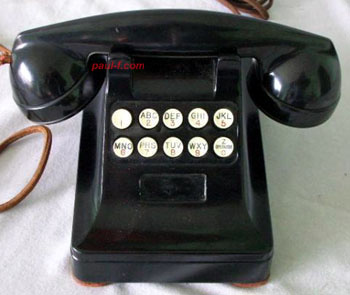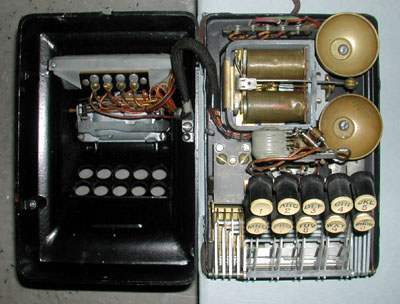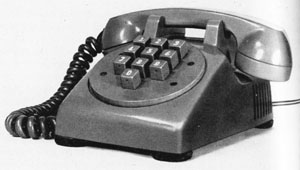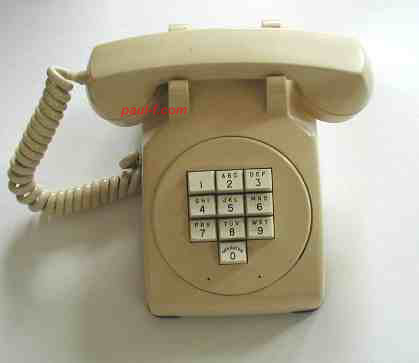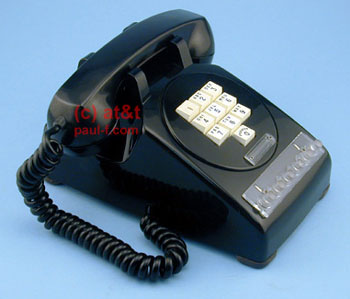This is a work in progress. Please send additions
and corrections.
I'm sure there are many "missing links" to be
discovered.
For background, read the DEVELOPMENT
OVERVIEW.
|
WE
1500 development timeline -- announced in 1964
|
|
1948 Pushbutton dial experiment
Built in a 302-style case with F1 handset. Two
rows of 5 keys on the front plucked reeds to produce two
tones for each digit. 2 out of 6 frequencies.
Based on a design tested at Bell Labs in 1941 and put on
the shelf during World War II.
The same tones were used between phone company offices
for signaling among operators.
Tested in 1948 on the first No. 5 crossbar switch in
Media, PA with families of 35 Pennsylvania Bell
employees. "The plucked reeds were found not to be
stable and rugged enough to maintain adjustment with
constant usage in a station environment."*
After the transistor was developed, research turned to
electronic oscillator designs.
For more detailed photos, click here.
* A History
of Engineering and Science in the Bell System,
Switching Technology (1925-1975), page 166.
(Top photo from Alan
Wallace. Edited and used with permission.)
(Lower photo taken at Lucent Archives. Used with
permission.)
|
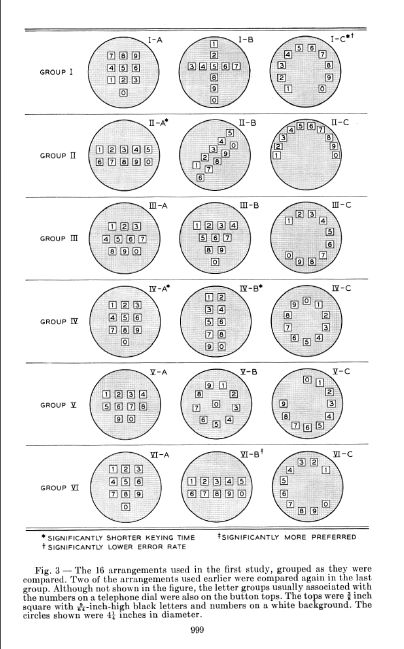
Source: Bell System Technical Journal,
July 1960, p. 999
"Human Factors Engineering Studies of the Design and
Use of
Pushbutton Telephone Sets," by R. L. DEININGER
|
During the mid-1950s,
several human factors studies were conducted to help
determine the best layout for button on the dial face.
In addition, the impact of other physical factors on
dialing speed and accuracy were studied.
The full article can be found by searching for the
article title in the index to Bell System Technical
Journal articles in the TCI Library:
TCI
Library
- BSTJ Index
From the article introduction:
"From the user's point
of view, what are the desirable characteristics of pushbuttons for use in
500-type telephone sets? The studies reported bear on
this question and also on questions of how people
process information when keying telephone numbers.
Four categories of design features were studied: key
arrangement, force-displacement characteristics,
button-top design and central office factors. The
results indicate that considerable latitude exists for
key set design in terms of user performance; however,
the preference judgments are more selective. The
studies also showed that the manner in which the
person acquired and keyed the telephone number
influenced performance appreciably."
|
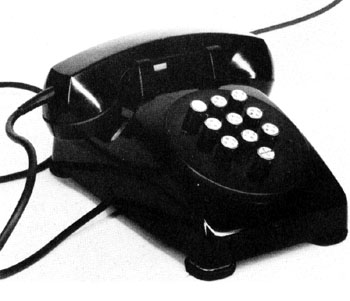
|
ca. 1955 500 set
with experimental pushbutton dial.
Photo Caption:
Bell Laboratories are experimenting with this 500-type
telephone which employs a "push-button" dial.
Engineers believe this principle of dialing, similar to
the key-pulse dialing used today by long distance
operators, may provide faster and more accurate customer
dialing.
(Photo from The Ohio
Bell, Aug-Sept 1955)
|
See "Tone Ringing and Pushbutton Calling," Bell System
Technical Journal, March 1958, page 340.
|
? (pre-1958)
Modified 500 set with a 10-digit crosspoint switch. 1 of
10 frequencies.
Experimental tone ringer.
In-house laboratory tests. Limited field trials in
Americus, GA and Crystal Lake, IL.
|
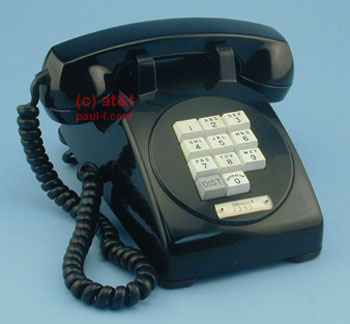
|
1958
F-53176 11/58
Early prototype uses standard 500 components with a new
dial pad. 2 out of 8 frequencies.
(Image courtesy of
AT&T Archives and History Center, San
Antonio. Used with permission.)
The DIST key signalled that the user was about to dial a
10-digit long distance number. It was proposed to
be included on ALL production tone sets. If
adopted, it would have required that all rotary sets be
replaced! (Sounds like eliminating analog cell
phones and analog TVs today.) Fortunately, they
realized that if the user simply dialed "1" first,
rotary phones could still be used.
|
|
|
1959
F-53139 11/58
As above without "DIST" button.
Note holes for clear number card holder.
Technical trials in Hamden, CT (step-by-step) and Elgin,
IL (common control) -- about 200 in each city.
F-53140
"Display sample"
Dial mounted in a keyset.
(Bottom image
courtesy of AT&T Archives and History Center,
San Antonio.
Used with permission.)
|
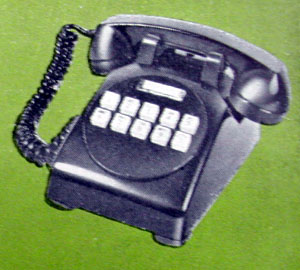
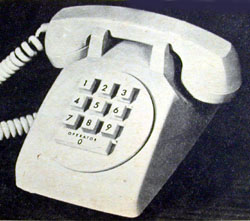
|
ca. 1959
Alternate button layouts
From Bell System Publications
|
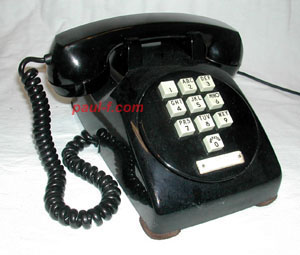
|
1960
F-53700 4/60
Square buttons. Revised pad.
Technical Trials in Cave Spring, VA (step-by-step) and
Hagerstown, MD (common control) -- about 100 in each
city. Each line supported both Touch Tone and
pulse dialing.
Field Trials (marketing trials) in Findlay, OH (11/60)
and Greensburg, PA (2/61). Included desk, wall,
Princess, keyset, Call Director and coin station sets
with the same keypad.
NOTE: Northern Electric had a regular
production 1500-type phone that looks a lot like this
model, and is occasionally confused with it. Check
carefully for "Western Electric" or "Northern
Electric" markings on the housing and handset.
See a NE 1500 set here
|
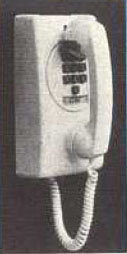
|
1962
Wall set prototype using a later pushbutton
configuration.
The new dial installed in a standard 554 set.
From a Bell System ca. 1962 brochure.
|
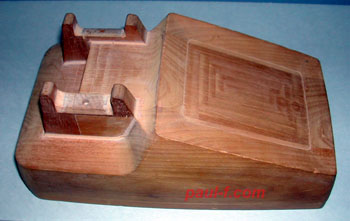
|
One of many wood models made to test various contours
for the base shell of the 1500 desk set.
(Photo taken at
Lucent Archives. Used with permission.)
|
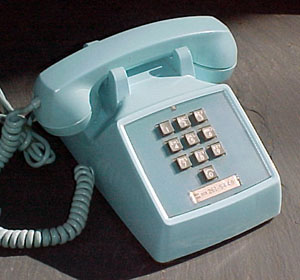
|
WE
1500D -- as announced in November, 1963
It got its own case with a "modern" facelift.
The faceplate is separate from the Touch Tone pad, so is
easy to change if damaged, to quickly change the set's
color or to upgrade from 10-button to 12-button dials
(plan ahead).
Earliest sets had charcoal gray faceplates.
The 1500 was previewed in 1962 at the Seattle World's
Fair. Debut at the New York World's Fair in 1964,
with over 3500 phones and an exchange in
operation. Included 1400 phone booths with
paystations and 10 "family booths" with speakerphones.
Production started in 1963.
Touch Tone service was introduced on November 18, 1963
in Carnegie and Greensburg, Pennsylvania at an extra
charge. ("Events in
Telephone History" AT&T) Service was
gradually expanded to the entire Bell System over the
following few years.
For models produced, go
here: WE 1500-SERIES
|
Princess
(1702) development timeline -- announced in 1964
|
The
touch
tone Princess was a natural evolution from the rotary
Princess design.
Back to Rotary Princess
Development Timeline
|
|
|
1960
F-53741
TouchTone Princess Set
Note the rectangle around the dial and the number card
holder that is similar to the 400-series keyset holder,
held on with two pins.
Also featured in a 1962 Bell System ad, "No end to
Telephone Progress."
Model number found on Trial Instruction No. 147, Issue
1, October 1960.
Field trials in 1960 in Findlay, OH, 1961 in Greensburg,
PA and 1965 in Suburban Chicago.
|
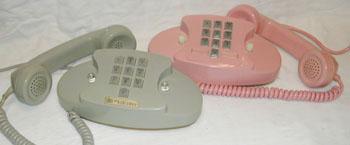
|
WE 1702B -- as
announced in 1964
The gray set is the Western Electric. The
bezel around the Touch Tone pad is flat and buttons are
clear.
The pink set is the Northern Electric version. For
some reason, they retained the rectangle around the keys
and white buttons. Note also that the number card
is split, with half on either side of the "0" key.
Production started in 1966.
For models produced, go
here: PRINCESS SETS
|
Touch
Tone Trimline development timeline -- announced in
1967
|
The
touch
tone Trimline was a natural evolution from the rotary
Trimline design.
Rotary and Touch Tone models were designed and tested in
parallel beginning with the Shmoo design.
Back to Rotary
Trimline Development Timeline |
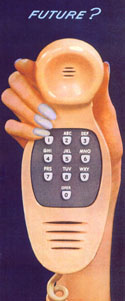
|
From a Bell System 1960 ad showing the concept for a
Touch Tone "Pushbutton-In-Handset" phone based on the
rotary dial-in-handset model that was in field trial at
the time. |
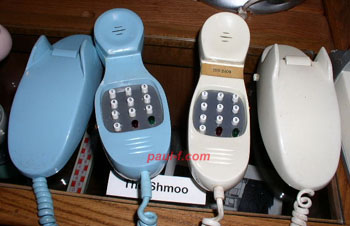
|
2 models for the Touch Tone pushbutton-in-handset
phone.
The blue set was patterned after the rotary "Shmoo" set
in field trial, while the white one was the size of the
rotary "Contour."
http://www.paul-f.com/weproto.html#Shmoo
Note the different handset widths to test grip comfort,
the switch to round buttons and the addition of 2 extra
buttons. Curiously, the 0 key was on the left, not
in the center.
(Photo courtesy of
Wayne Merit.
Used with permission.)
|
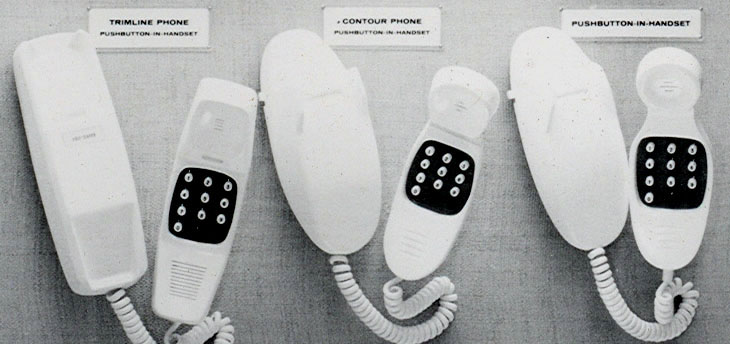
(CLICK IMAGE FOR
LARGER VIEW)
|
Trimline,
Contour and
Pushbutton-In-Handset ("Shmoo")
3 competing 12-button designs from the
Experimental Phones display
(Courtesy
of SBC Archives and History Center, San Antonio,
Texas.
Used with permission.)
|
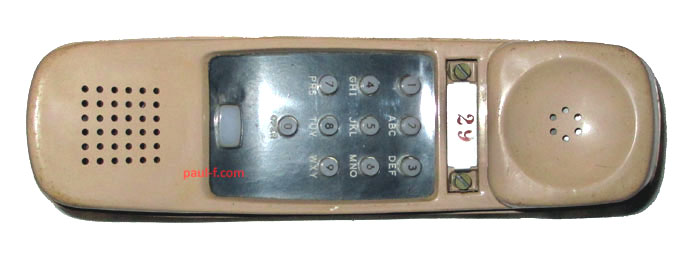
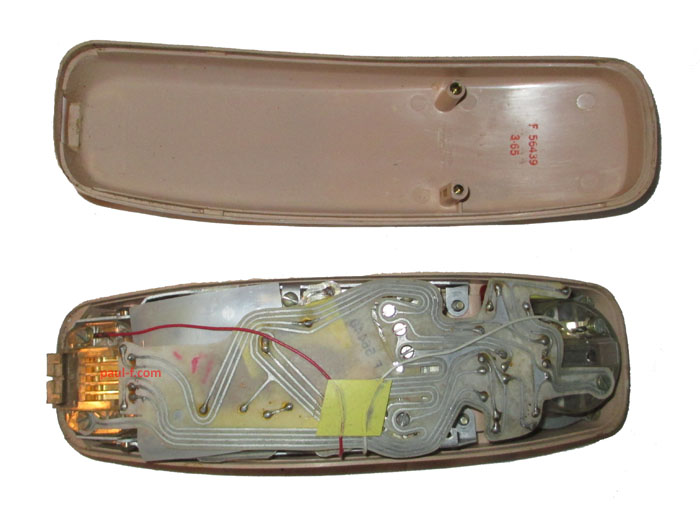
|
1965
F-56439 3-65
Touch Tone Trimline
Flexible circuit marked F-56440
Trials were held in 1965 in Chicago, IL. 200 sets.
|
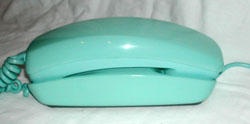
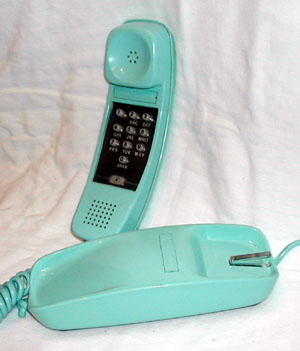
|
Trimline Touch Tone
-- as announced in 1967
Production handsets were marked 1220A inside the
handset's back cover.
Bases were stocked seperately and mated with handsets at
installation time. Installers could then mix and
match to get a rotary or TouchTone handset with a desk
or wall base.
AC1 - wall base (see rotary page)
AD1 - desk base (shown here)
10-button pad, round buttons.
Returned to holes over the transmitter and receiver.
Transmitter and receiver elements are replaceable.
5-conductor handset cords plug in to base and handset,
so parts could be mated in the field during
installation.
Production began in Indianapolis in 1966.
General availability in 1967.
For models
produced, go here: TRIMLINE SETS
|
Others
(by date)
|
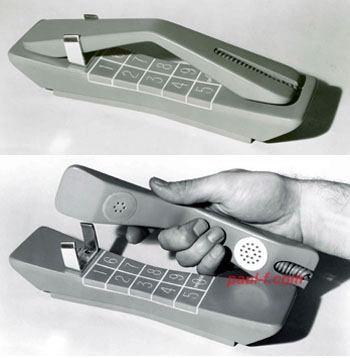
|
1959
"Longfellow" design concept wood model.
(Image courtesy of
AT&T Archives and History Center, San Antonio.
Used with permission.)
|
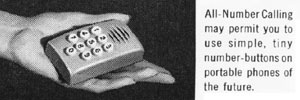 |
Interesting concept from a 1960 ad. I doubt that
it was built at the time, but looks suspiciously
familiar over 40 years later! |
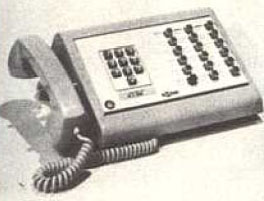
|
1962
Call Director - Touch tone dial replaced the rotary
dial.
From a Bell System ca. 1962 brochure.
|
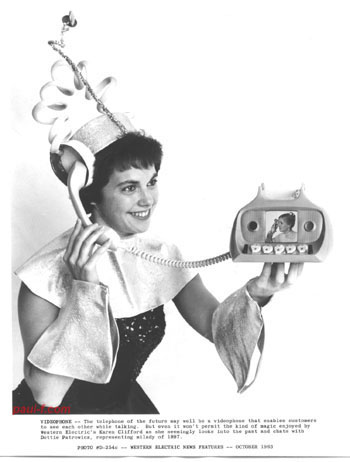
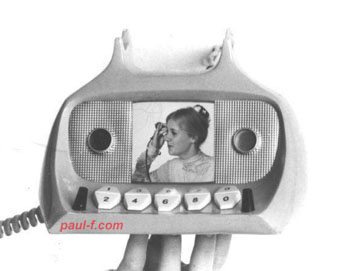
|
1963
Video phone concept
From a photo used in the October 1963 issue of Western
Electric News Features.
(Courtesy of Wayne
Merit.
Used with permission.)
For more on picturephones,
go here: WE
Picturephones
|
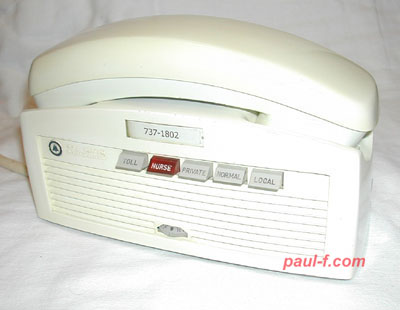
|
1964
Hospital Interphone Patient Set
F 55903 1/64
10-button TouchTone Trimline Handset (rotary also
available)
Speakerphone for hands-free operation. Privacy
switch cuts off microphone.
This model was for small hospitals. Toll and Local
switches select lines for outgoing calls. The
larger hospital models don't have these switches, as the
PBX operator assigned outgoing lines.
Also F 55873, without toll and local keys for larger
hospitals.
|
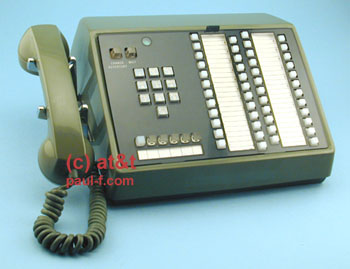
|
1965
Selective Dialer
F56466 12-64
Keyset with integrated repertory dialer, 48 number
capacity. Buttons on upper left are change
repertory and wait.
Probably a step toward the touch-a-matic.
(Image courtesy of
AT&T Archives and History Center, San Antonio.
Used with permission.)
|
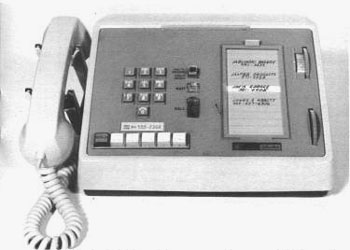
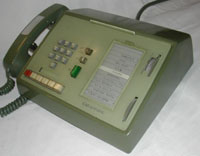
|
1966
Call-A-Matic keyset with integrated dialer.
Remembers up to 500 numbers on magnetic tape, without
the need for external cards as used in the 660 and 2660
series card dialers.
(B&W scan
courtesy of Wayne Merit.
Used with permission.)
|
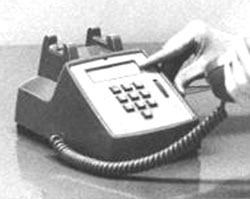
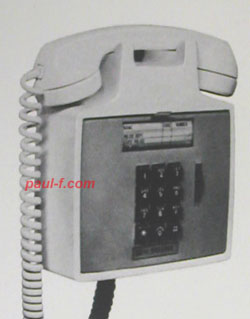
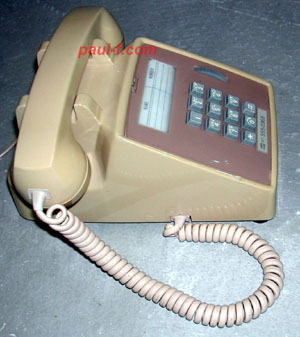
|
1966
1500 desk set with built-in phone directory.
Not an automatic dialer. Thumbwheel moves a paper
directory. Number must be manually dialed.
In field trial during summer 1966.
(Scan courtesy of
Wayne Merit.
Used with permission.)
- - - - -
Wall Set with Directory
From a Bell System publication
- - - - -
1966
2500 desk set with built-in phone directory.
F-56731 10/66
Note the use of a G12 handset and Trimline-style handset
cord.
(Photo taken at
Lucent Archives. Used with permission.)
|
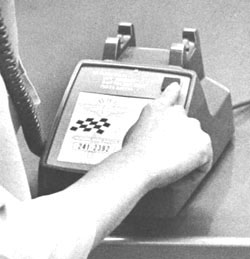
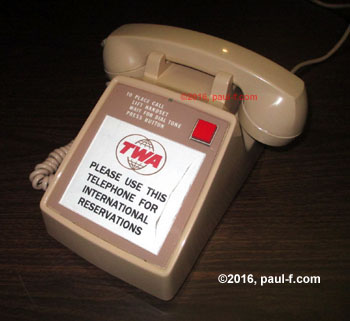
That's one
large dial card!
|
1966
Single button dial phone.
Never a wrong number.
Dials a pre-set number over the public network. Used for
a reservation or information hot-line.
Planned for trial in 1966.
(Scan courtesy of
Wayne Merit.
Used with permission.)
- - - - -
F-56750 5-66 #110
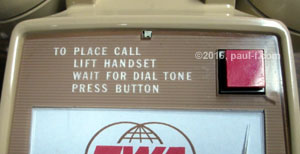
Dialing directions
are molded into the faceplate.
Pushing the button causes a small synchronous
motor to dial a phone number of up to 14 digits.
This found set was programmed for a 7-digit (local)
number.
The number is programmed using 28 jumper wires
attached to screw terminals - not intended to be
changed often.
See: "Never a Wrong Number! F-56750 One-button
Preset Automatic Dialer," Singing Wires,
Jan 2020
|
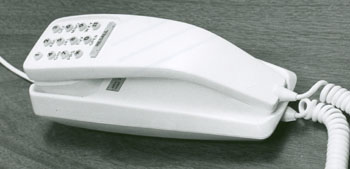
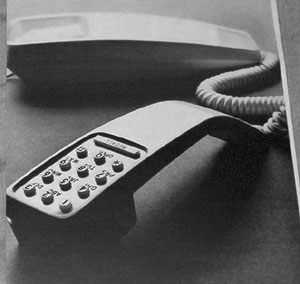
|
1968
Dial-In-Handset
Uses integrated circuit technology.
(Top photo courtesy
of SBC Archives and History Center, San Antonio,
Texas.
Used with permission.)
Also seen in a 1970 Bell System ad (below).
|
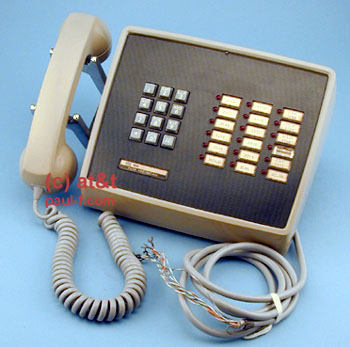
|
1969
Keyset with LED display lights
F-57628 2-69
G12 handset. Number card holder also labeled "Push
for recall"
(Image courtesy of
AT&T Archives and History Center, San Antonio.
Used with permission.)
|
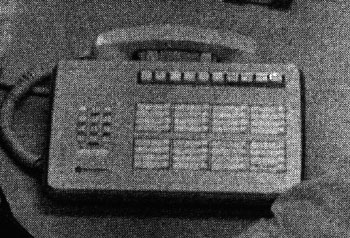
|
1973
Touch-a-matic Prototype - 32 memory buttons
From Bell Labs News, 3/73
Anyone have an F-code or better photo?
|
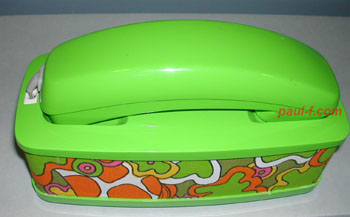
|
ca. 1974
Unmarked Accent prototype with Trimline handset and cord
retractor.
(Photos taken at
Lucent Archives. Used with permission.)
For
info on production Accent sets, go here:
|
Other touch tone models
are shown here:
Experimental Phones Display
Disneyland House of Tomorrow
Display
Western Electric Design Models
Western Electric Picturephone
Evolution
|
Continue to rotary models.
|

